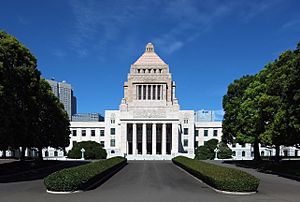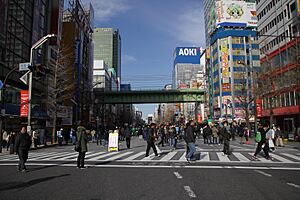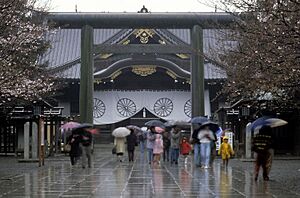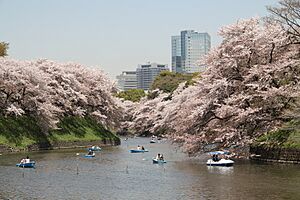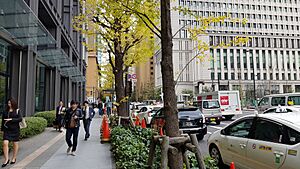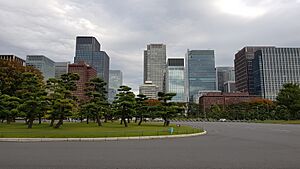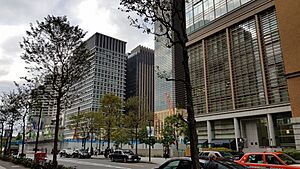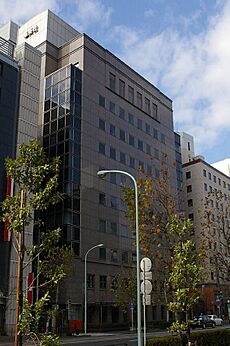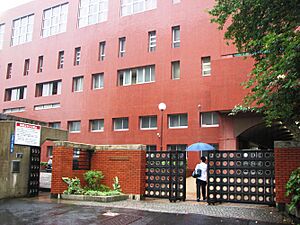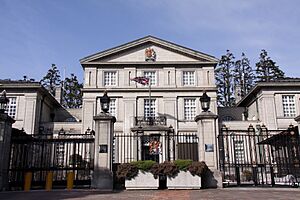Chiyoda, Tokyo facts for kids
Quick facts for kids
Chiyoda
千代田区
|
|||||||||||||
|---|---|---|---|---|---|---|---|---|---|---|---|---|---|
| Chiyoda City | |||||||||||||
|
Clockwise from top:
|
|||||||||||||
|
|||||||||||||
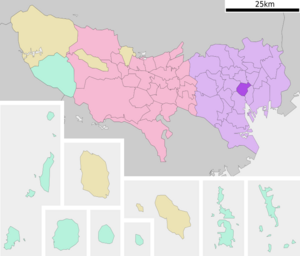
Location of Chiyoda in Tokyo
|
|||||||||||||
| Country | Japan | ||||||||||||
| Region | Kantō | ||||||||||||
| Prefecture | Tokyo | ||||||||||||
| Area | |||||||||||||
| • Total | 11.66 km2 (4.50 sq mi) | ||||||||||||
| Population
(October 1, 2020)
|
|||||||||||||
| • Total | 66,680 | ||||||||||||
| • Density | 5,710/km2 (14,800/sq mi) | ||||||||||||
| Time zone | UTC+09:00 (JST) | ||||||||||||
| City hall address | 1-2-1 Kudanminami, Chiyoda, Tokyo 102-8688 |
||||||||||||
|
|||||||||||||

Chiyoda, also known as Chiyoda City, is a special part of Tokyo, Japan. It's right in the middle of Tokyo's 23 special wards. Chiyoda is home to the Tokyo Imperial Palace and the area around it. It is famous as the main political and financial hub of Japan.
As of October 2020, about 66,680 people live here. This makes it the least populated of Tokyo's special wards. The total area of Chiyoda is about 11.66 square kilometers (4.5 square miles). A big part of this area, about 22%, is taken up by the Imperial Palace, Hibiya Park, the National Museum of Modern Art, and Yasukuni Shrine.
Chiyoda is a huge financial center for Japan. Areas like Otemachi, Marunouchi, and Yurakucho are east of the palace. These areas are home to the main offices of many large companies. They also create a big part of Japan's economy. During the day, about 850,000 people come to Chiyoda for work, which is much more than the number of people who live there! Tokyo Station, which is Japan's busiest train station, is also located in Chiyoda.
Chiyoda is also the political heart of the country. Its name, "Chiyoda," means "field of a thousand generations." This name comes from Chiyoda Castle, which is now the Imperial Palace. The Emperor lives in the Imperial Palace. Many important government buildings are also in Chiyoda. These include the National Diet (Japan's parliament), the Prime Minister's Official Residence, and the Supreme Court. Famous Tokyo landmarks like Yasukuni Shrine and the Nippon Budokan are also here. Other well-known neighborhoods in Chiyoda are Akihabara, Iidabashi, and Kanda.
Chiyoda was created in 1947. It was formed by joining two older areas called Kanda and Kōjimachi. This happened when Tokyo City became the Tokyo Metropolis. Today, Chiyoda has two different parts. The Kanda area is like the old commercial center of Tokyo. The western part of Kōjimachi is more like a fancy, upscale district.
Contents
History of Chiyoda
Chiyoda has been an important place where many historical events happened. Its central location has made it a key spot for major moments in Japan's past.
- In 1860, a famous event involving Ii Naosuke took place near the Imperial Palace.
- In 1932, a prime minister named Inukai Tsuyoshi was attacked here.
- In 1936, a significant event known as the February 26 Incident occurred.
- In 1960, a political leader named Inejirō Asanuma was attacked in Hibiya Hall.
- In 1995, a serious incident involving a group called Aum Shinrikyo happened in the Tokyo subway system.
Geography of Chiyoda
Chiyoda is located in the very center of what used to be Tokyo City. It sits on the edge of the Musashino plateau. The Imperial Palace takes up the central part of the ward.
- The east side of Chiyoda is next to Chūō. This is where Tokyo Station is located.
- The south side borders Minato. Here you will find Hibiya Park and the National Diet Building. This area is mostly used for government offices.
- The west and northwest parts of Chiyoda are mostly upscale residential areas. The Yasukuni Shrine is also located here.
- To the north and northeast, there are more residential neighborhoods and the busy Akihabara shopping area.
Chiyoda's Cityscape
Chiyoda has many tall buildings. As of 2001, there were over 6,500 buildings with four or more stories.
Some parts of Chiyoda don't have many people living in them. This is because they are parks, like Hibiya Koen. Or they might be full of office buildings, like Otemachi or Marunouchi. Some districts are also very small. For example, Kanda-Hanaokachō only includes Akihabara Station and the Yodobashi Camera store.
Districts and Neighborhoods
Chiyoda is divided into two main areas: the Kōjimachi area and the Kanda area.
Kōjimachi Area
The Kōjimachi area used to be called Kōjimachi Ward.
- Kojimachi is an older merchant area. It has some offices but is mostly an upscale residential spot. You can find the Portuguese, Irish, and Belgian embassies here.
- The Banchō area is a fancy residential area. It has six neighborhoods and is home to several embassies, including Belgium, Paraguay, and the UK.
- Chiyoda is where the Imperial Palace is officially located.
- Fujimi has the Philippine Ambassador's Residence and many schools.
- Hayabusachō is home to Japan's Supreme Court of Japan and the National Theater.
- Hibiya Kōen is a large park south of the Imperial Palace.
- Hirakawachō has a mix of homes and medium-sized offices.
- Iidabashi is another important district.
- Kasumigaseki is the main center for Japan's government offices.
- Kioichō got its name from three powerful families who had their homes here long ago.
- Kitanomaru Park is north of the Imperial Palace. It's where the Nippon Budokan is located.
- Kōkyo Gaien are large open gardens in front of the Imperial Palace.
- Kudanminami and Kudankita are around the Kudanshita station. They are prestigious areas for homes and businesses. The Yasukuni Shrine is here.
- Marunouchi is between Tokyo Station and the Imperial Palace. It's one of Tokyo's main business areas.
- Nagatachō is where the National Diet (Japan's parliament) is located. The Hie Shrine is also here.
- Ōtemachi is north of Marunouchi. It's a district with major Japanese financial companies and big national newspapers.
- Uchisaiwaichō is near Hibiya Park. It has the Imperial Hotel and the main offices of banks like Mizuho Financial Group.
- Yūrakuchō is south of Marunouchi and is part of the Tokyo Station business district.
Kanda Area
The Kanda area used to be called Kanda Ward. Soto-Kanda, in the northern part of the ward, is home to the famous Akihabara electronics district.
Some of the main Kanda neighborhoods are:
- Uchi-Kanda
- Soto-Kanda
- Nishi-Kanda
- Higashi-Kanda
- Iwamotochō
- Kajichō
- Hitotsubashi
There are also many smaller neighborhoods in the Kanda area. Their names often start with "Kanda-", like Kanda-Awajichō or Kanda-Jinbōchō.
Population Changes
The number of people living in Chiyoda has almost doubled since 2000. Before that, the population had been going down for a while.
Fun Places to Visit
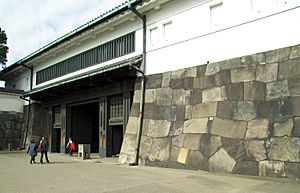
Chiyoda has many interesting places to see:
- Akihabara: Famous for electronics, anime, and manga.
- Hibiya Park: A beautiful park for relaxing.
- Imperial Palace: The home of the Emperor of Japan.
- National Diet Building: Where Japan's government makes laws.
- Nippon Budokan: A famous arena for concerts and sports.
- Tokyo International Forum: A large convention and arts center.
- Tokyo Station: A huge and busy train station.
- Tokyo Takarazuka Theater: A theater for musicals and performances.
Parks and Outdoor Fun
Chiyoda has several lovely parks and outdoor areas:
- East Imperial Garden: This garden is part of the Tokyo Imperial Palace grounds. It has parts of the old Edo Castle and opened to the public in 1968.
- Kitanomaru Park: Located on the former northern part of Edo Castle. Here you can find the Tokyo National Museum of Modern Art and the Nippon Budokan.
- Chidorigafuchi Boat Arena and Moat Path: This area has a waterway where you can go boating.
- National Diet Building Park: This park is next to the Diet Building. It has American dogwood trees, which symbolize the friendship between the United States and Japan.
- Hibiya Park: This was Japan's first park designed in a Western style. It has restaurants, outdoor concert areas, and tennis courts.
- Imperial Palace Outer Garden: This large open space in front of the Nijubashi Bridge is great for jogging and sightseeing.
Economy of Chiyoda

Chiyoda is a major business hub. In 2001, it had over 36,000 businesses with nearly 900,000 employees. Many well-known Japanese companies have their main offices in Chiyoda. These include:
- Asahi Glass
- Calbee (known for snacks)
- Japan Post Holdings
- JFE Holdings
- Kadokawa Corporation (publishing)
- KDDI (telecommunications)
- Konica Minolta (electronics)
- Mitsubishi Estate (real estate)
- Mitsubishi UFJ Financial Group (banking)
- Mizuho Financial Group (banking)
- NTT docomo (mobile phones)
- Seven & i Holdings (retail, like 7-Eleven)
- Shogakukan (publishing)
- Shueisha (publishing, like Weekly Shonen Jump)
- Sony Music Entertainment Japan
- Toho (film studio)
- Tokyo FM (radio)
- Toppan Printing
- Yamazaki Baking Company
- YKK Group (zippers and building materials)
- Yomiuri Shimbun (newspaper)
Some international companies also have their Japanese offices in Chiyoda. These include Hewlett-Packard Japan and LVMH.
Transportation
Chiyoda is home to the huge Tokyo Station. This station is a major hub for many subway lines, local trains, and long-distance train services. It connects Chiyoda to all parts of Tokyo and Japan.
Education in Chiyoda
Chiyoda has many schools for different age groups.
Primary and Secondary Schools
As of 2003, Chiyoda had eight elementary schools and five junior high schools. The local government runs these public schools. The Tokyo Metropolitan Government runs the public high schools.
Public Schools
- Prefectural High Schools
- Hibiya High School
- Hitotsubashi High School
- Municipal Secondary (Junior-Senior High) Schools
- Kudan Secondary School - located in Kudankita
- Municipal Junior High Schools
- Kōjimachi Junior High School - in Hirakawachō
- Kanda-Hitotsubashi Junior High School - in Hitotsubashi
Students in Chiyoda can choose which junior high school they want to attend.
- Municipal Elementary Schools
- Banchō Elementary School - in Rokubanchō
- Chiyoda Elementary School - in Tsukasamachi. This school was formed in 1993 by combining two other schools.
- Fujimi Elementary School - in Fujimi
- Izumi Elementary School - in Izumichō. It was created in 1993 by combining two schools.
- Kudan Elementary School - in Sanbanchō
- Kōjimachi Elementary School - in Kōjimachi. It was formed by merging two schools.
- Ochanomizu Elementary School - in Fujimi. This school was created in 1993 by combining three schools.
- Shohei Elementary School - in Sotokanda. It was established in 1993.
Private Schools
- Primary and Secondary Schools
- The Tokyo Chinese School is located here.
- The Lycée Franco-Japonais de Tokyo (French-Japanese School) used to be in Fujimi.
- Secondary Schools (Junior and Senior High)
Many private girls' schools are in Chiyoda, such as:
- Chiyoda Jo-Gakuen Junior and Senior High School
- Kanda Jo-Gakuen Junior and Senior High School
- Kyōritsu Joshi Junior and Senior High School
- Futaba Gakuen Junior and Senior High School
- Joshigakuin Junior and Senior High School
- Miwada Gakuen Junior and Senior High School
- Ōtsuma Junior and Senior High School
- Shirayuri Joshi Gakuen Junior and Senior High School
- Wayō Kudan Joshi Gakuen Junior and Senior High School
There are also private boys' schools:
- Gyosei Junior and Senior High School
- Seisoku Gakuen Senior High School
Other private high schools include:
- Kinjō Gakuen Senior High School
- Tōyō Senior High School
- Nishōgakusha Senior High School
- Primary Schools
- Gyosei Primary School (boys' school)
- Futaba Gakuen Elementary School (girls' school)
- Shirayuri Joshi Gakuen Elementary School (girls' school)
Colleges and Universities
Chiyoda is home to several universities and graduate schools.
- Hitotsubashi University's Graduate School of International Corporate Strategy is here.
- Both campuses of Sophia University are in western Chiyoda.
- Globis University Graduate School of Management, a large business school, is also in Chiyoda.
- Other universities like Hosei University, Meiji University, Senshu University, and Nihon University are located in the area.
Libraries
Chiyoda has several libraries for everyone to use.
- The city operates four public libraries: the Chiyoda Library, Yobancho Library, Shohei Library, and Kanda Library.
- The Tokyo Metropolitan Library Hibiya Library is also here.
- The Japanese government runs the National Diet Library and the National Archives.
Embassies in Chiyoda
Many countries have their embassies in Chiyoda. This shows how important Chiyoda is for international relations.
 Bangladesh
Bangladesh Belgium
Belgium East Timor
East Timor Holy See
Holy See India
India Ireland
Ireland Israel
Israel Luxembourg
Luxembourg Mexico
Mexico North Korea (Chongryon)
North Korea (Chongryon) Palestine
Palestine Paraguay
Paraguay South Africa
South Africa Tunisia
Tunisia United Kingdom
United Kingdom
Images for kids
See also
 In Spanish: Chiyoda (Tokio) para niños
In Spanish: Chiyoda (Tokio) para niños











